#sashiko-inspired
Text
More visible mending
Latest shashiko-inspired visible mending:
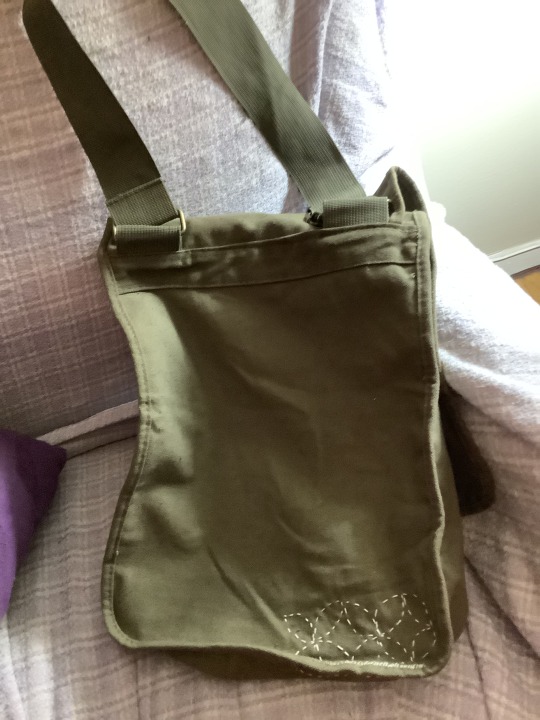
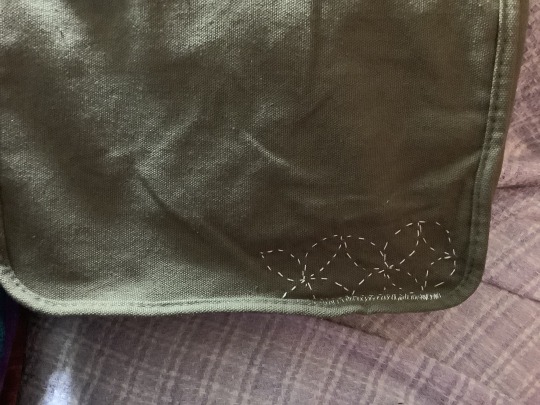
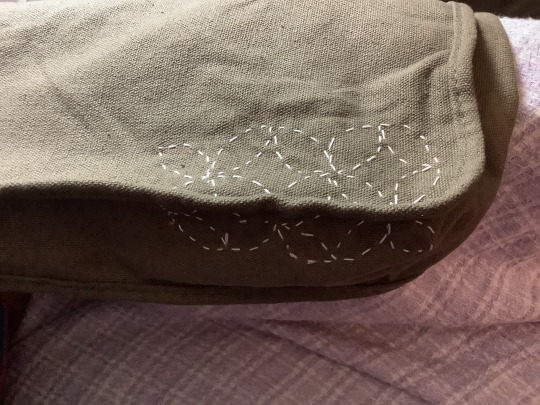
79 notes
·
View notes
Text

#crafts#crafting#mending#diy#sewing#embroidery#sashiko#visible mending#coworkers misunderstand and try to chastise me for being too humble when i argue with them for saying the top thing#so i made a meme about it#inspiration#?
19K notes
·
View notes
Text
I was reading a book on darning. Apparently the way I darn socks isn't an "official" technique 😂 although it shares some aspects with English darning. Whatever. I hated most of the techniques in the book 🤣 but it still indirectly inspired me to try combining sashiko with square darning.

This pair of pants tore a small hole in the knee ages ago. I've had them in my mending pile while I waited for inspiration to strike. Basically I ran random stitching vertical and horizontal, not trying for regular length of stitches or distance between lines, except in the very center where I picked up extra lines and then wove them from the opposite direction in a square darn.
Supplies: Olympus 100% cotton sashiko thread in navy (103), and a small metal mixing bowl for a darning "mushroom"
Work in progress, below. While the vertical lines were easy to keep straight by following the lines in the denim, horizontal proved impossible without drawing guidelines (in brown). (Not widely approved of, I'm sure, but kids super-washable Crayola fine tip markers are great for this imo. 👍 So far they've always washed out for me.)

The hole, from the reverse, because I always forget to take "before" photos:
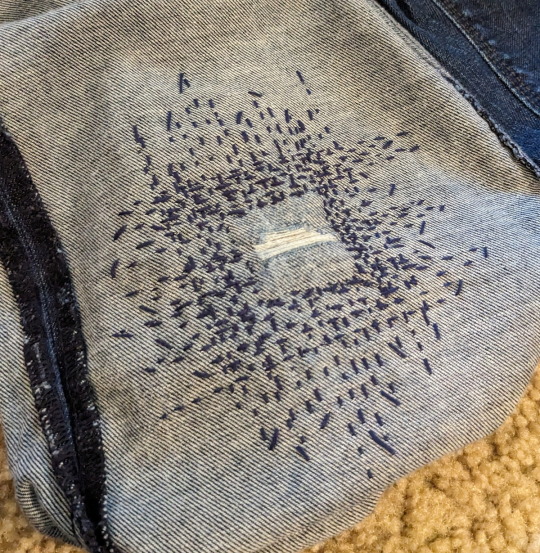
My only regret is that I didn't put an additional piece of denim behind the hole as reinforcement. That may or may not backfire on me. However, so far I'm very please with the outcome. I washed them, everything held up, and the patch is comfortable when wearing.
#mending#sashiko#sashiko inspired#darning#reduce reuse repair#fiber crafts#and after I finished this project I ordered about 5 more colors of thread#I have at least three more pairs of pants with holes and I feel inspired#visible mending
131 notes
·
View notes
Text
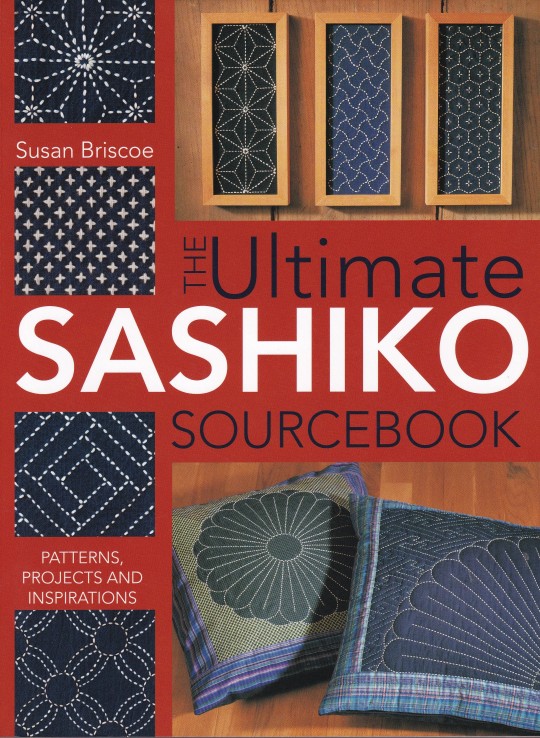
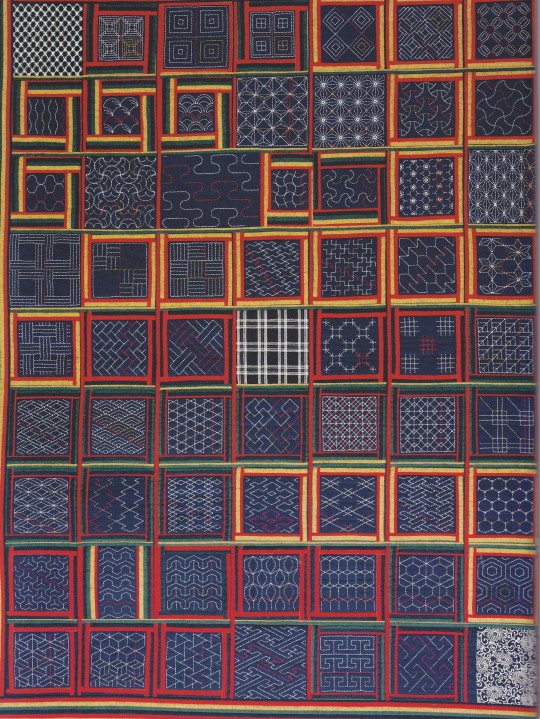




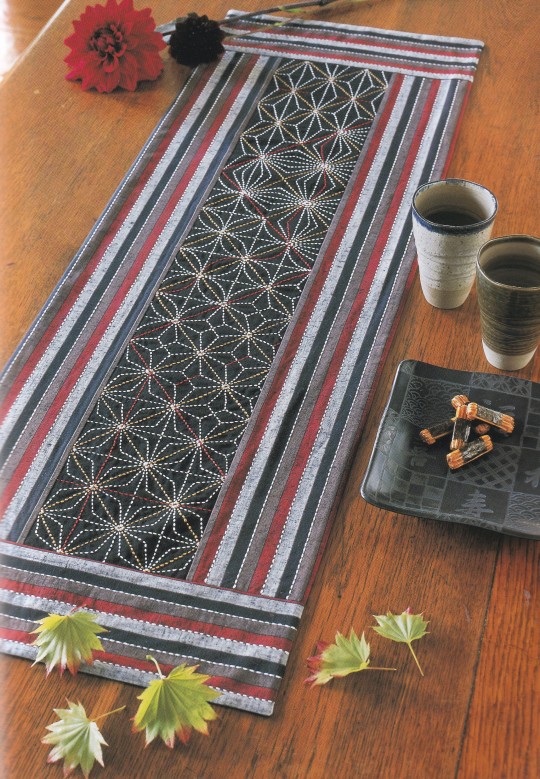
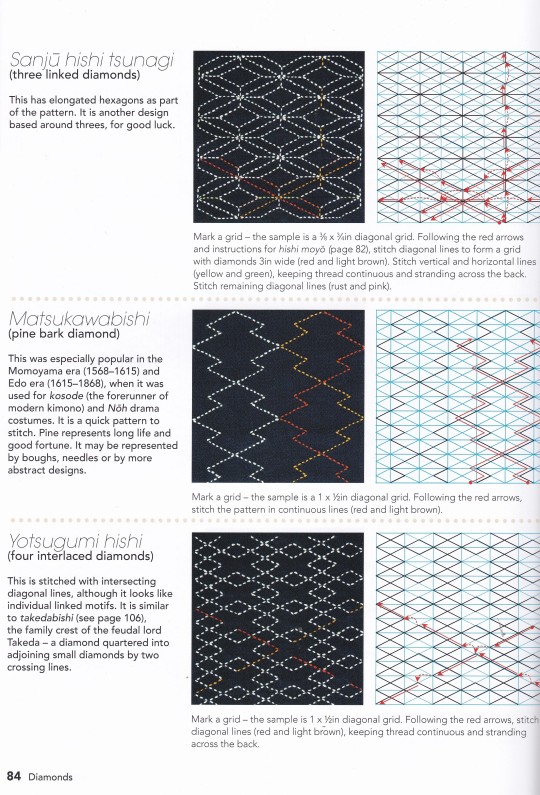


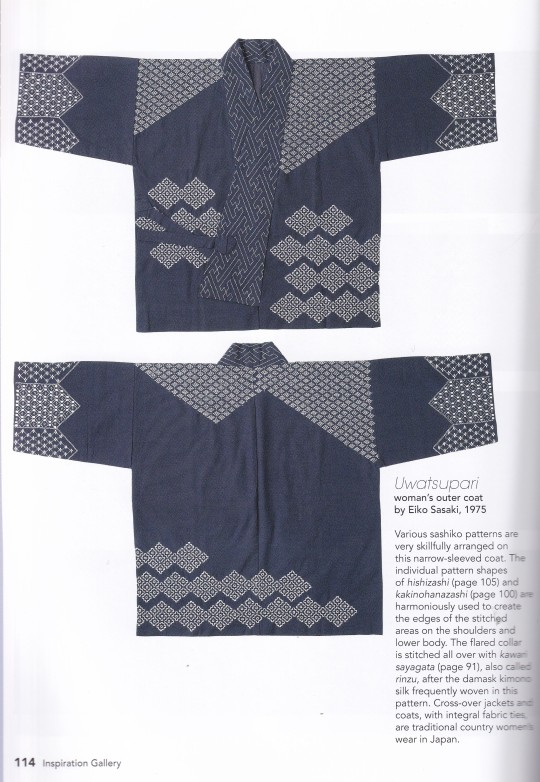
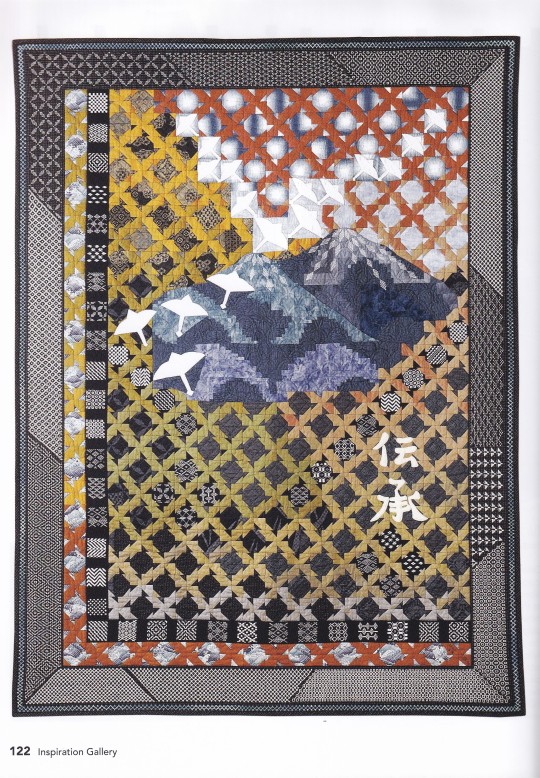
The Ultimate Sashiko Sourcebook
Patterns, Projects and Inspirations
Susan Briscoe
David & Charles, Exeter 2005, 128 pages, 21,5x28cm, paperback, ISBN 9780715318478
euro 22,00
email if you want to buy [email protected]
Sashiko, the traditional Japanese technique of needlework quilting, uses simple running stitch to create beautifully decorative patterns ideal for patchwork, quilting and embroidery. Sashiko (pronounced shash-ko) means 'stab stitch' and refers to the small running stitch that is worked to build up distinctive decorative patterns, of which there are hundreds. The book begins by exploring the origins of the technique to strengthen clothes and to make them warmer. Getting Started describes everything you need to begin stitching, including selecting suitable fabrics and threads, marking out patterns on the fabric, as well as the stitching technique itself. Ten project chapters show how easy it is to use sashiko patterns to make beautiful items for the home. The sashiko patterns are described in step-by-step detail in the pattern library, showing you exactly how to achieve each individual pattern with ease. Finally a gallery of work by contemporary Japanese textile artists provides extra inspiration.
25/01/24
#Sashiko#Japanese technique needlework quilting#textiles books#patterns#projects#inspirations#fashion books#fashionbookmilano
29 notes
·
View notes
Text

mending inspired by the “suns and crosses” design from erin eggenburg’s “the mending directory”
#what great fun!#let me know if the alt text is bad#mending#post i made#also should note that i assume most designs like this are somewhat inspired by japanese sashiko
20 notes
·
View notes
Text
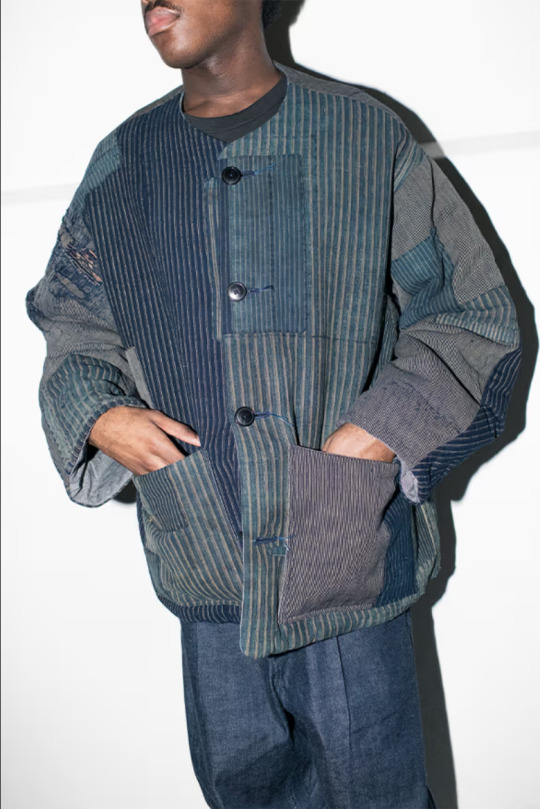
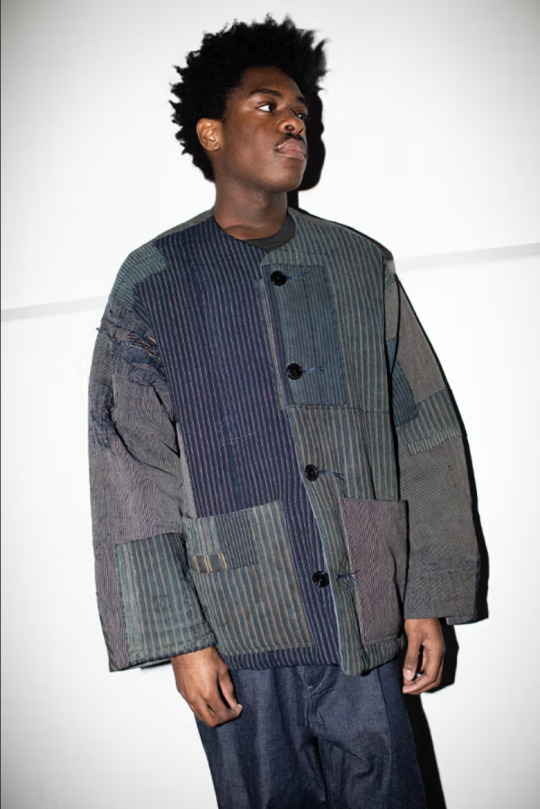
APPLIED ART FORMS
#applied art forms#boro#sashiko#japanese inspired#fashion#streetwear#style#indigo#vintage#distressed
24 notes
·
View notes
Photo

Le Bourgeron Sashiko is inspired by the typical work jackets of the 20's/30's, this variant by Fleurs de Bagne is made of a 14 oz. Sashiko cotton fabric from the traditional Japanese weaving mill Kuroki. Today in combination with: - Le "Bourgeron Sashiko" in Indigo, Le Chèche in jaquard indigo and Le Pantalon "Cargo Denim Selvedge" in Heavy Used by @fleursdebagne - Clampdown Shirt in Blue Chambray by @tellason_germany - Glasses Tray Round by #puebco - Convivio Mug in Navy by #cositabellini - Brass Ballpoint Pen by #travelerscompany - Solid Brass Keyhook and Solid Brass Anchor by #smokysumisstore #worldwideshipping 📦 #ootd #outfitinspiration #inspiration #menswear #mensfashion #menstyle #indigo #denim #sashiko #jacket #fleurdebagne #chambray #tellasondenim #tellason #accessories #homegoods https://www.instagram.com/p/CpH_etkIrvE/?igshid=NGJjMDIxMWI=
#puebco#cositabellini#travelerscompany#smokysumisstore#worldwideshipping#ootd#outfitinspiration#inspiration#menswear#mensfashion#menstyle#indigo#denim#sashiko#jacket#fleurdebagne#chambray#tellasondenim#tellason#accessories#homegoods
21 notes
·
View notes
Text
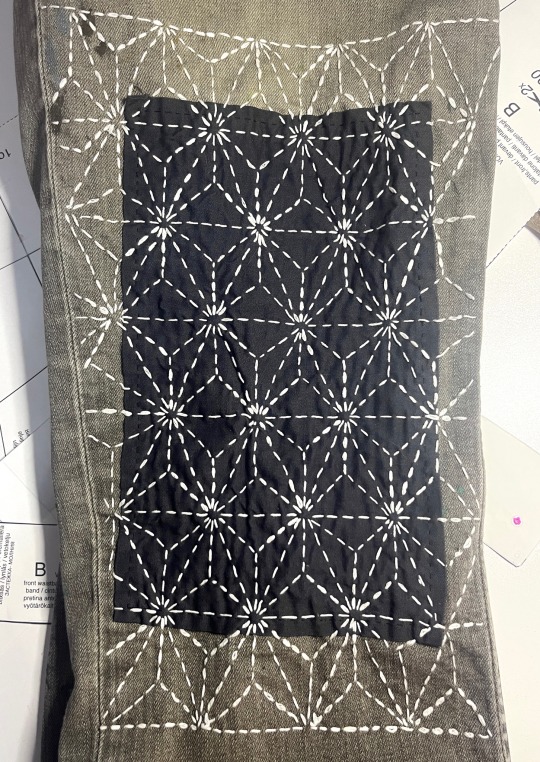
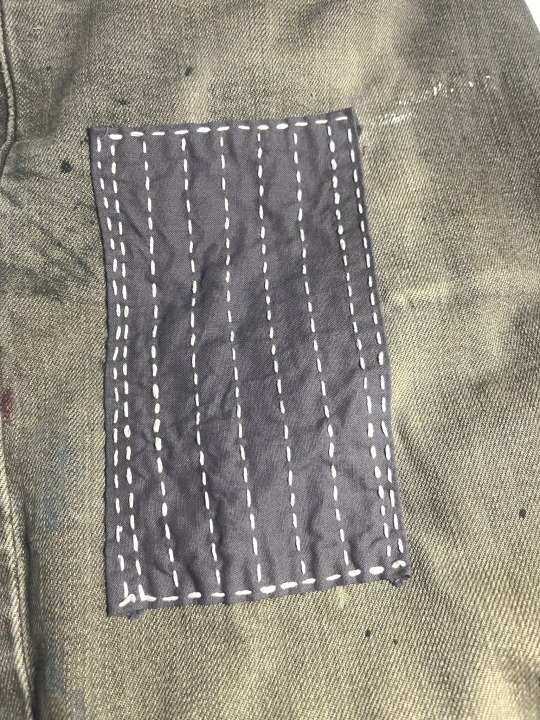
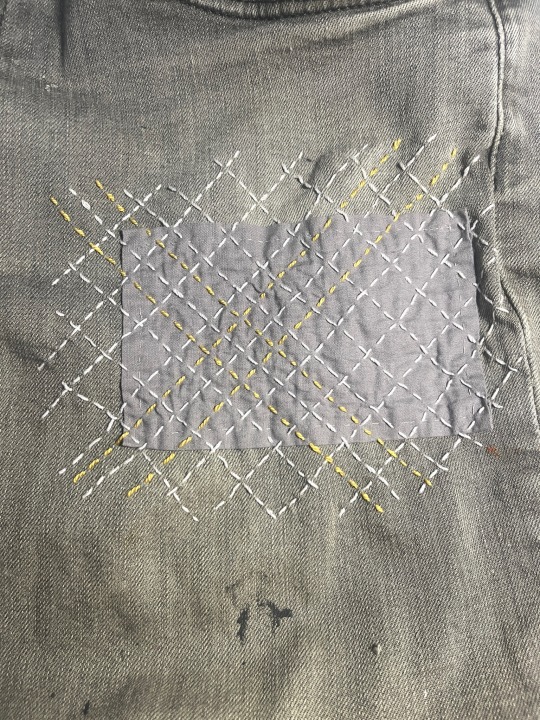
More sashiko inspired patches and mending!
I didn’t know that the traditional way to do a sashiko mend is to stitch the patch with the pattern and and then attach the patch to the clothing… but i still think it looks really cool! And it should still be plenty strong lol.
#sashiko stitching#sashiko#sashiko mend#visible mending#mending project#mending#hand sewing project#sewing project#diy mending#sustainable fashion
181 notes
·
View notes
Text



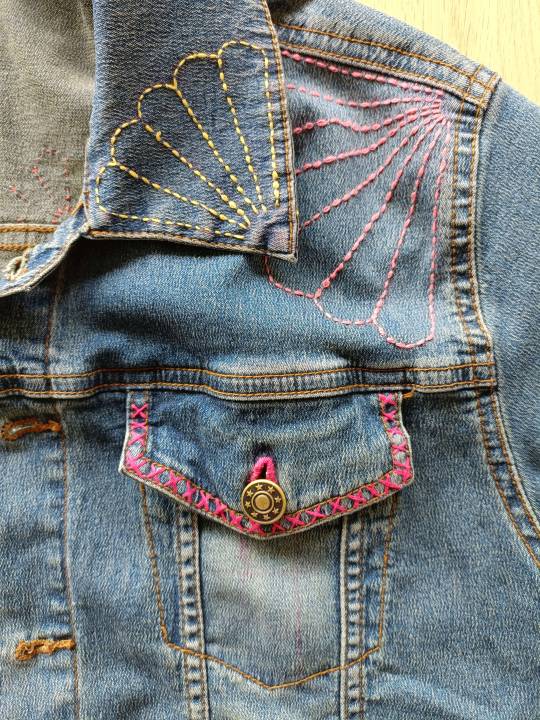
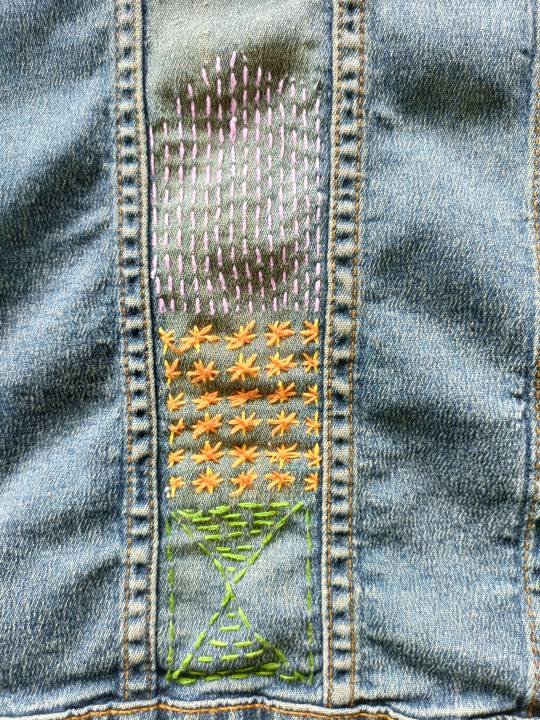


I've been embroidering on this denim jacket for about a month now, adding little colourful details that really press the satisfaction button in my brain. Some of it is sashiko, or sashiko-inspired, as I'm trying to learn that style. Many fingers have been sacrificed in this process. The dotted red and white cuff is added as a visible mending detail.
372 notes
·
View notes
Text

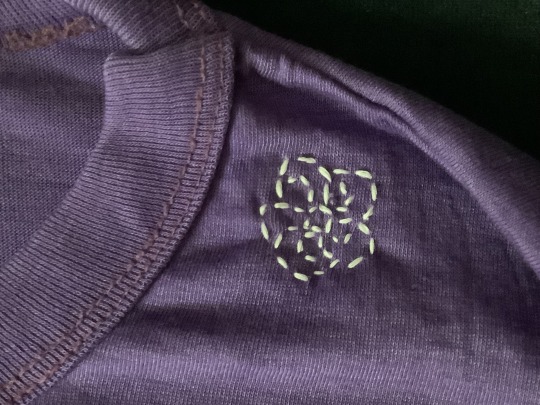


More sashiko-inspired visible mending
10 notes
·
View notes
Text
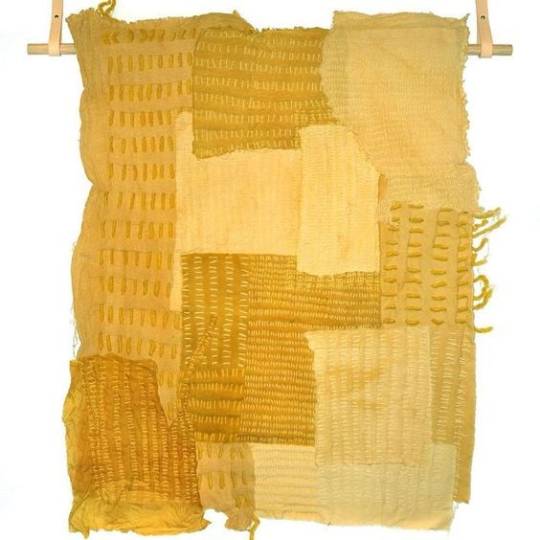
Lilian Dørge
Boro and sashiko inspiration in a Nordic interpretation with great respect for the original craft, culture and history. Plant color of Corylus avellana, Solidago on silk, cotton, wool, linen, all organic.
https://www.instagram.com/p/CDnaIL7hzuW/?
85 notes
·
View notes
Text

Naruto OC: Hitome Naka (水可ヒトミ Naka Hitome?, Thuỷ Khả Nhất Mục?) with a silk moth - her jutsu inspiration.
Shippuden Info:
Location: Konohagakure
Birthday: Feb 9th (age: 25)
Height: 160cm / Weight: 47kg
Rank: Chūnin
Classification: Sensor Type, Medical-nin
Occupation: Academy Teacher (speciality: pharmacognosy)
Natural Types: Water, Yin, Yang
Personality: Vulnerable, Stubborn
Tools: Wakizashi
Trivia: The name Hitome is from 一目刺し子 (Hitomezashi sashiko) - traditional Japanese stitching technique.
Jutsu:
Silk Manipulation
Poison Dust
Cocoon Dome
Aroma Ninjutsu
Sensing Technique
Hidden Pond Technique
Silk Clone
Water Release: Water Formation Wall
Water Release: Raging Tornado
Just another normal moment of the moth lady and her flame, Genma Shiranui (literally means unknow fire lol)

#naruto#naruto oc#naruto original character#oc x canon#oc x character#genma shiranui#genma shiranui x reader#genma x oc#genma x reader#naruto genma#my oc#my art
21 notes
·
View notes
Text
:: Slow Fashion & Mending Kits ::
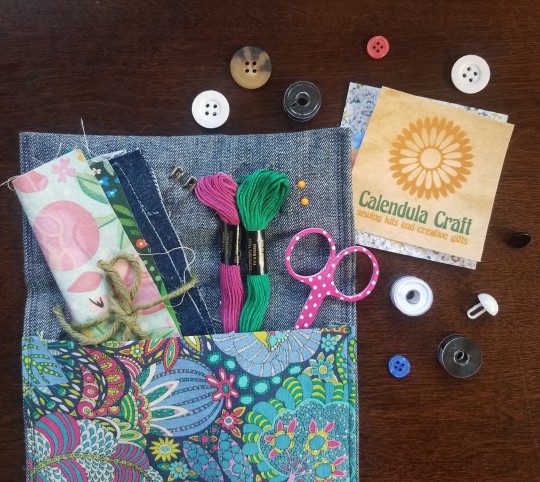
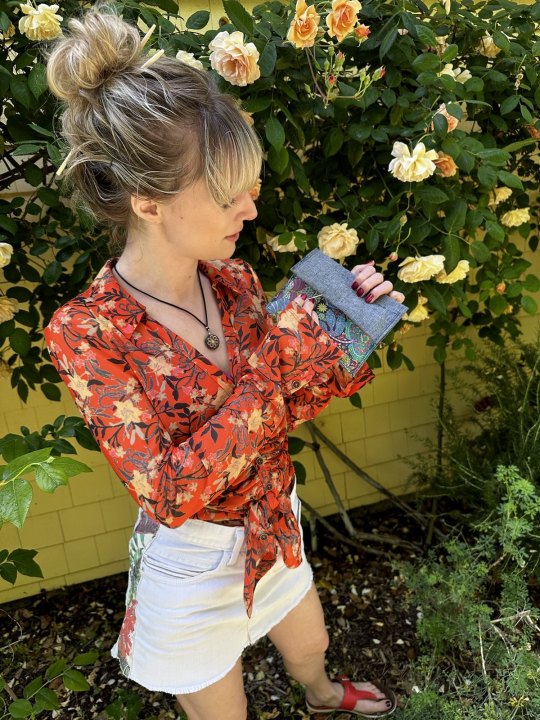

By repairing holes and fixing straps, a beloved item of clothing can last years longer than if left un-mended and save unnecessary waste from going to the landfills. Inspired by a desire to make clothing last longer, many crafters are getting into the art of mending and upcycling.
This Sewing Kit is for sewers on-the-go and includes all the tools for a well-rounded sewing kit like:
- 1 pair of trimming scissors
- 2 sturdy sewing needles
- 3 spools of thread
- 4 patches
- 8 pins, large & small
- a collection of fun & useful buttons
You can find this kit and many more on the Calendula Craft Etsy page.
((Many thanks to my sister, Jana of the 90's, for modeling her kit))
#diy#mending#slow fashion#witchy crafts#upcylcing#upcycled fashion#handmade#sewing#cottagecore#cottage crafts#fashion#repair culture
55 notes
·
View notes
Text

I got inspired by sashiko embroidery and made this bookmark to try it out
14 notes
·
View notes
Text
DIY Sashiko Sampler Potholders
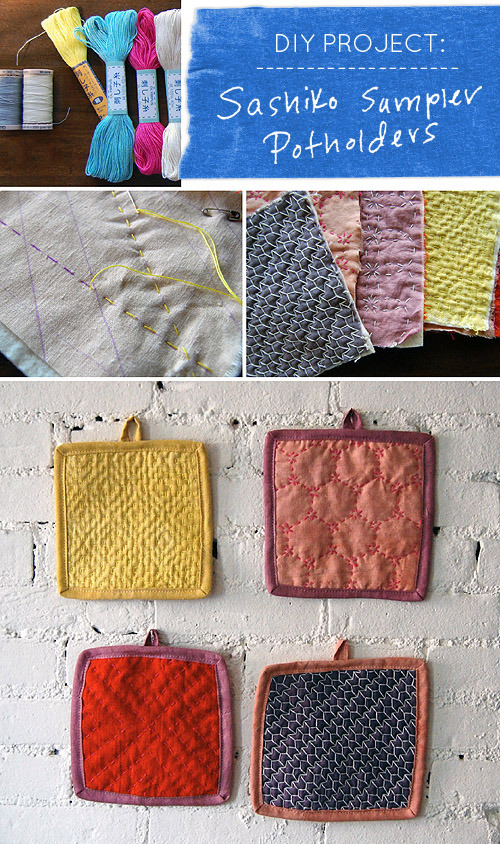
Project by Natalie Stopka:
These sweet potholders are a great way to experiment with simple stitches and dashing color combinations. Sashiko is a decorative running stitch used in Japan to reinforce fabrics while forming tessellating geometric patterns. Following that tradition we will use the oldest stitch in the book to quilt a vibrant and utilitarian collection of potholders – and the perfect hostess gifts!
A note about materials: It is imperative that only natural fibers are used for this project – synthetics will burn. That means cotton or linen fabric, cotton batting, cotton embroidery thread, and even cotton machine quilting thread to bind the edges. Traditional sashiko needles are very long (2 1/2”) with a sharp point and small eye. You can purchase genuine needles or simply substitute the longest sewing needle you’ve got. –Natalie


Materials
-low loft cotton batting
-linen or cotton fabric
-safety pins
-sashiko thread, or embroidery floss sashiko needle, or long needle
-vanishing fabric marker or chalk pencil
-scissors
-ruler
-straight pins
-cotton sewing thread
-iron and board
-optional: tear-away stabilizer, permanent marker, thimble, sewing machine
Steps:
Begin by finding your lovely patterns! Check out Pinterest for inspiration. Simple geometric designs can be drawn directly on the fabric with a vanishing fabric marker, or complex patterns can be traced onto tear-away stabilizer with a permanent marker. This paper- like sheet is pinned to the surface of the fabric, sewn through, and torn off when the embroidery is complete.
Pre-wash your fabric. Cut two pieces of fabric and one piece of batting to about 8” square. Lay the batting between the fabric and pin the layers in place with a few safety pins. Draw out your pattern or affix the stabilizer.

To begin the embroidery, hide your knot between the fabric and batting. Following the pattern, sew a running stitch with large and (more or less) even stitches through all three layers of fabric and batting. Put several stitches onto the long needle before pushing it through the fabric, using a thimble if necessary. Divide each line segment of the pattern into an even number of stitches to keep your spacing uniform across the pattern, and keep the tension a little loose to prevent puckering in the wash.

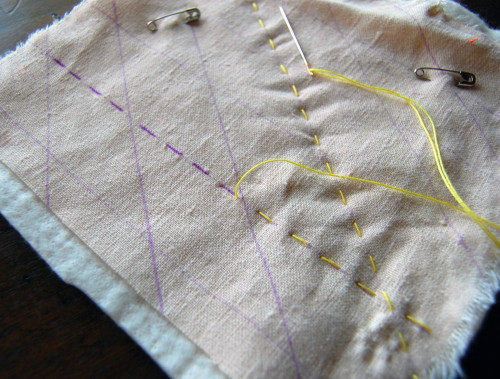
When the sashiko embroidery is complete, bind the edges of the potholder. Cut a few long strips of fabric about 1 3/4” wide (these do not need to be on the bias). Join two strips together if necessary to reach around the edge of the potholder. Pin the binding strip along the edge of the potholder on whichever side you deem the back, 1/8” from the edge. The raw edges will be parallel, with the binding strip laying over the embroidered pattern. Leave two tails where the ends of the binding strip will be joined.
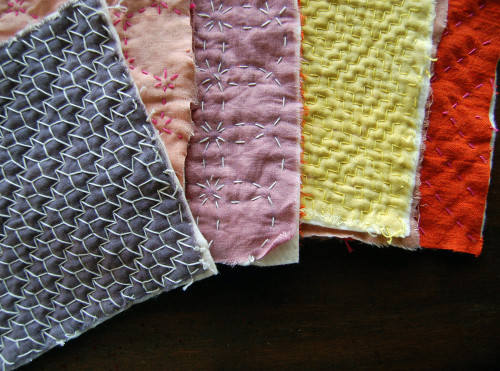
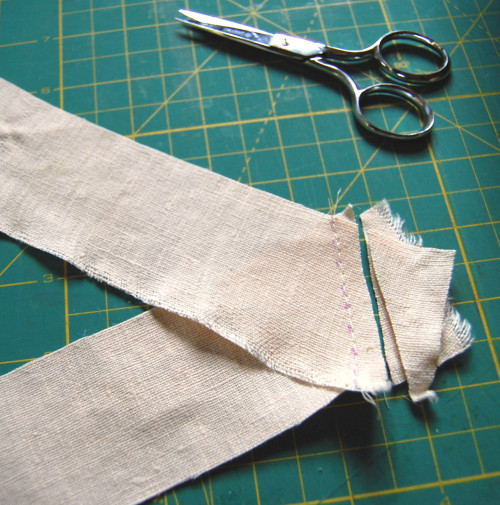
Sew the binding strip around the edge of the potholder 1/4” from the edge, using a sewing machine if you like. At each corner there will be a triangular flap of fabric – simply sew to the corner, lift the presser foot and flip the triangle from the next edge to the sewn edge, lower the presser foot and continue. When you reach the side where the binding strip will be joined, pin the seam and join the ends before attaching the binding strip to the potholder.
To add the fabric loop: Cut a piece of fabric 1” wide by 3” long. Fold the long sides to the center and press, then fold in half lengthwise and press again (just like bias tape). Sew down the length of this and make it into a loop. Snip a few stitches at the center of one side of the potholder and slip the ends of the loop between the binding strip and the potholder, with the loop pointing towards the center of the potholder. Re-sew the seam, securing the loop in place.
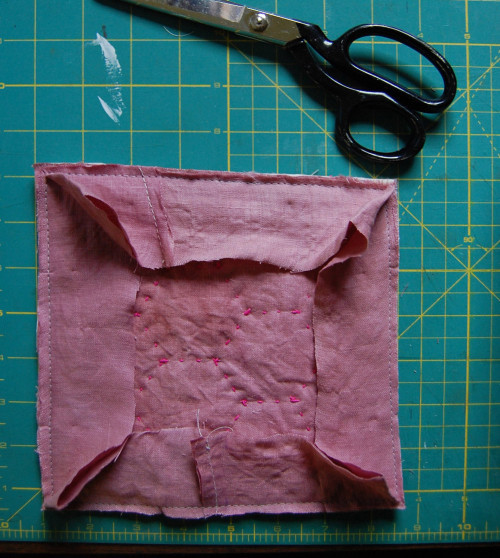


Trim the edge of the potholder (and loop ends) flush with the edge of the binding strip, 1/8” from the seam. Invert the binding strip so it wraps around the edge of the potholder to the front. Press the back with a warm iron, then turn front-side up. Fold the outer edge of the binding strip to meet the edge of the potholder and press. Fold this crisp new seam onto the front of the potholder covering the edge. Press again, working your way around the sides. When you reach each corner you will create a little triangle; fold the next side over this to make the mitered corner. Sew the binding strip into place, securing the edges of the potholder.

7 notes
·
View notes
Note

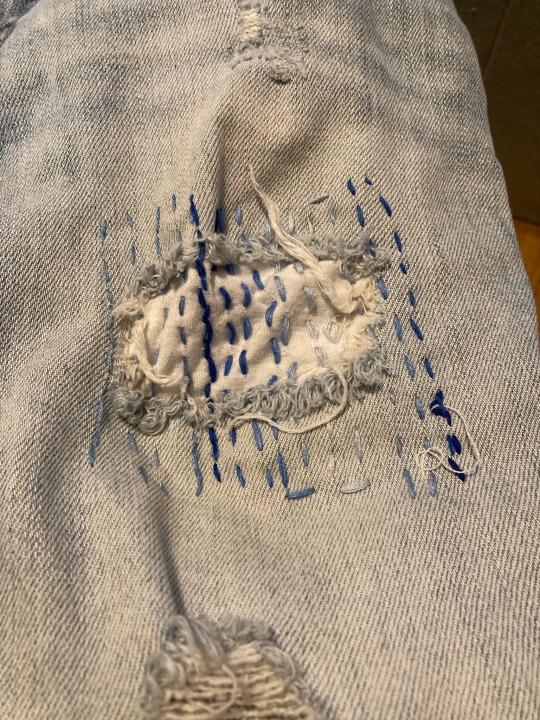
My first sashiko mending project! Love your blog, it’s very inspiring!
[ID: two pictures of holes in a light blue denim garment. Both holes have been patched with white fabric. The hole in the picture on the right has running stitches in variegated blue thread running across the mend.]
Congrats on your first sashiko project! Have fun wearing your mended garment. :)
#wasteless crafts#ask#sashiko#visible mending#mending#sashiko mending#denim#jeans#diy#fashion#fast fashion#slow fashion#sustainable fashion#sustainability
93 notes
·
View notes